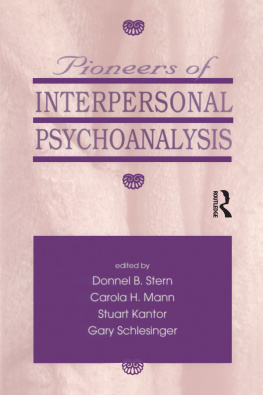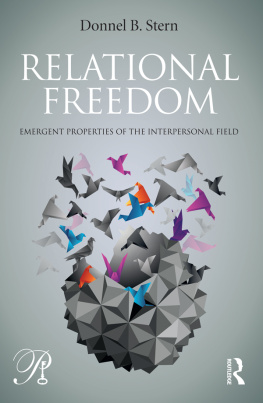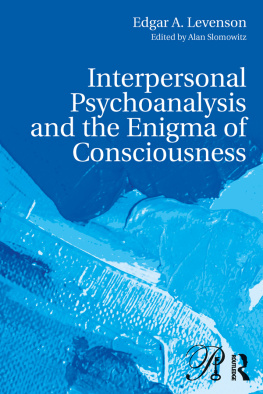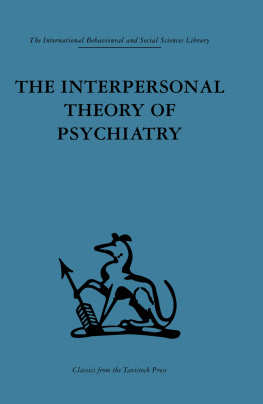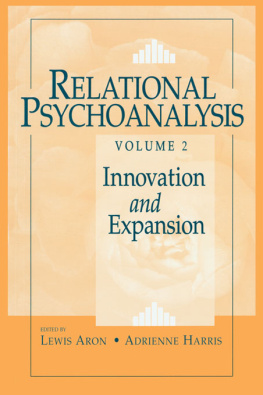PIONEERS
OF
INTERPERSONAL
PSYCHOANALYSIS
ABOUT THE EDITORS
Donnel B. Stern, Ph.D. is a Supervising Analyst and member of the Faculty at the William Alanson White Institute, the Manhattan Institute of Psychoanalysis, and the Institute for Contemporary Psychotherapy. He is on the Editorial Boards of Contemporary Psychoanalysis and Psychoanalytic Dialogues.
Carola H. Mann, Ph.D. is a Training and Supervising Analyst, Fellow, member of the Faculty, and Director of Continuing Professional Education at the William Alanson White Institute. She is also a member of the Faculty and Supervisor at the Westchester Center for the Study of Psychoanalysis and Psychotherapy.
Stuart Kantor, Ph.D. is a member of the Teaching Faculty, Supervisor of Psychotherapy, a Supervising Analyst, and Director of Adolescent Treatment Service at the William Alanson White Institute. He is also an Adjunct Assistant Professor of Psychology and Education at Teachers College, Columbia University.
Gary Schlesinger, Ph.D. is a member of the Faculty at the William Alanson White Institute and is an Adjunct Assistant Professor of Psychology at New York University.
PIONEERS
OF
INTERPERSONAL
PSYCHOANALYSIS
edited by
DONNEL B. STERN
CAROLA H. MANN
STUART KANTOR
GARY SCHLESINGER
First published 1995 by The Analytic Press, Inc.
This edition Published 2014 by Routledge
711 Third Avenue, New York, NY 10017, USA
27 Church Road, Hove, East Sussex, BN3 2FA
Routledge is an imprint of the Taylor & Francis Group, an informa business
1995 by The Analytic Press, Inc.
All rights reserved. No part of this book may be reproduced in any
form, by photostat, microform, retrieval system, or any other
means, without the prior written permission of the publisher.
Library of Congress Cataloging-in-Publication Data
Pioneers of interpersonal psychoanalysis / Donnel Stern [et al.].
p. cm.
Includes bibliographical references and index.
ISBN 0-88163-177-9 (hardcover). ISBN 0-88163-216-3 (paperback)
1. Psychoanalysis. 2. Interpersonal relations. 3. Psychotherapist and
patient. I. Stern, Donnel.
RC506.P564 1995
616.8917DC20
95-30973
CIP
Typeset by AeroType, Inc.
CONTENTS
to John Fiscalini
by Gerard Chrzanowski
by Earl G. Witenberg
by Marylou Lionells
by Miltiades L. Zaphiropoulos
by Jerome L. Singer
by Edgar A. Levenson
by Marianne Horney Eckardt
by Benjamin Wolstein
by Arthur H. Feiner
by Philip M. Bromberg
by George Goldstein and Roanne Barnett
by Edward R. Clemmens
by Amnon Issacharoff
I nterpersonal psychoanalysis as we know it today is rooted in the thinking of Harry Stack Sullivan and Erich Fromm. Starting in the 1930s, these men, along with Frieda Fromm-Reichmann, Clara Thompson, Karen Horney, Janet Rioch Bard, David MacKenzie Rioch, and others, worked out a new psychoanalytic way of understanding, one based in interpersonal relations, not drive. In 1943, this same group (minus Fromm-Reichmann, who was based at Chestnut Lodge in Massachusetts, and Horney, who went her own way and formed a separate training institute) joined together in New York City as the founders of the William Alanson White Institute of Psychiatry, Psychoanalysis, and Psychology. The present volume, conceived by Carola Mann, Ph.D., is a memorial to that first generation of White Institute interpersonalists and to those psychoanalysts-to-be who enrolled at the White Institute in its very early days. Reprinted here are important, often classic, articles by the now-deceased pioneers of the interpersonal perspective. Our intention, in this era of theoretical tolerance and pluralism among psychoanalysts, is to draw attention back to the work of writers who worked in the interpersonal vein when it required genuine courage to do so. Since our purpose is to memorialize this vanished era and some of the people who made it what it was, we have reprinted the articles in the chronological order of their publication. Though we have not, of course, edited the articles for content or expression, we have recast their formats so they would appear here in a uniform style. Whenever it was possible, we also modernized and completed those references that were archaic and incomplete. In a few cases, we were unable to do this; those references appear in their original form. References cited in the introductions are listed at the back of the book, preceding the index.
This collection does not include writers who might well be considered pioneers of the interpersonal movement but who were not centered at the White Institute, such as Mabel Blake Cohen, Leslie Farber, Lewis Hill, Karen Horney, Edith Weigert, and Otto Will. Even limiting attention to past writers from the White Institute, though, did not allow us to reprint articles by all those we would have liked to include. Max Deutscher, Gloria Friedman, and Roberta Held-Weiss are the most notable of this group. Nor, given our intention to put together a memorial volume, could we include articles by living pioneers Gerard Chrzanowski, Marianne Horney Eckardt, Arthur H. Feiner, Edgar A. Levenson, Rollo May, Ruth Moulton, Rose Spiegel, Alberta Szalita, Earl Witenberg, Benjamin Wolstein, and Miltiades Zaphiropoulos, who are today the most influential senior contributors to the interpersonal psychoanalytic literature. Most of them have published throughout each of the last four decades. We are privileged that several of them have contributed introductions to the chapters in this volume.
Interpersonal psychoanalysts were among the first to think about the informative value of countertransference, and several of the classic articles in this book illustrate that fact. Janet Rioch Bards paper appeared in 1943, Ralph Crowleys in 1952, and Edward Taubersunbelievably radical and open minded for his timein 1954. Mabel Blake Cohen, Clara Thompson, and Benjamin Wolstein also published important work on the topic during the 1950s. The paper of Erwin Singers chosen for this volume appeared some years later, in 1971, and its full embrace of the idea that psychoanalysis is inevitably a reciprocal interaction reflects the growth in interpersonal views of transference-countertransference during the 1960s.
Another area of early exploration among the interpersonal group was the intensive dynamic psychotherapy of psychotic patients, which Sullivan, Fromm-Reichmann, Otto Will, and a few others were the first to practice and conceptualize. Fromm-Reichmanns paper in this volume was part of that early thrust. Clara Thompson, along with Karen Horney and (within a few years) Ruth Moulton, recognizing the shortcomings of Freuds views of women, pioneered the neoFreudian psychology of women. One of Thompsons significant articles in this area appears here. Ernest Schachtel was an early and trenchant critic of libido theory, and his Metamorphosis, published in 1959, remains a masterwork of developmental psychoanalysis. Schachtels article On Memory and Childhood Amnesia is undoubtedly his most widely known article, but because it has been republished frequently, we have chosen for this volume his equally important 1954 article on the development of focal attention and reality. Harry Bone, while not a prolific writer, did have a good deal of influence as a teacher. His article here illustrates the longstanding interest many interpersonalists have had in delineating the relationship between interpersonal and intrapsychic phenomena.

